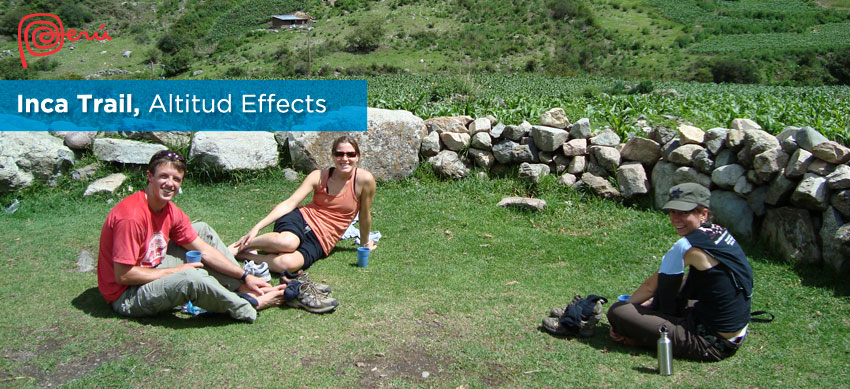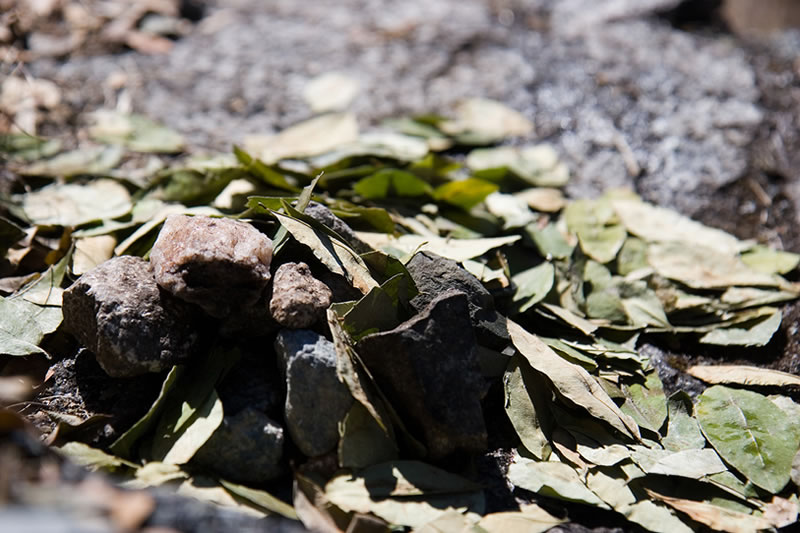
Altitude sickness is suffered by all tourists who arrive in Cusco. The reason is the 3,399 meters of altitude in which this city is located. All the people who, from one moment to another, go from a flat geography to a mountainous one of great elevation; they will experience altitude sickness. The Inca Trail to Machu Picchu crosses landscapes over 4,200 meters high. How to prevent this evil during this walk? Learn more in this article.
- What is altitude sickness? What are your symptoms?
- Is it serious to suffer from altitude sickness?
- Is it possible to suffer altitude sickness on the Inca Trail?
- Tips to reduce the symptoms of altitude sickness on the Inca Trail
- The coca leaf to calm altitude sickness
- Additional information about altitude sickness on the Inca Trail
What is altitude sickness? What are your symptoms?
Altitude sickness is a natural reaction of the body of those who go from a flat geography to a mountainous geography higher than 2,400 meters above sea level (7,874 feet elevation).
This results in a reduction in atmospheric pressure and oxygen levels in the body. As you climb higher, the air becomes scarcer. The heart and lungs have to work twice as hard to supply oxygen to the tissues. While the heart is the pump, which circulates the blood, the lungs carry vital oxygen to the red blood cells, for delivery to the muscles, brain and other organs.
The demand of the muscles depends on the level of activity, but the brain needs a large amount of oxygen (15% of the total). If your brain lacks oxygen due to the speed with which you ascended and made great effort, you will have the following symptoms:
- Difficulty to sleep
- Dizziness
- Fatigue
- Headache
- Lack of appetite
- Nausea or vomiting
- Rapid pulse
- Respiratory difficulty when performing physical effort.
Is it serious to suffer from altitude sickness?
Fortunately, the symptoms of altitude sickness tend to improve as the person adapts better to the high altitude geography in which they are.
However, if some precautions are not taken, the symptoms may get worse. These are the degrees of the disease, from mild to moderate and severe:
- Mild altitude sickness : it is bearable and can be controlled with rest and plenty of water.
- Moderate altitude sickness : it is more uncomfortable and unpleasant. Because it presents with vomiting, intense headaches and shortness of breath, the same that occurs even after having rested.
- Severe altitude sickness : It can develop if the symptoms of moderate altitude sickness are ignored and alcoholic beverages or very fatty foods are ingested. Symptoms include ataxia (loss of muscle coordination and balance) that can cause confusion, cough, chest stiffness or congestion, spitting up blood, pale or gray complexion, inability to walk in a straight line, and shortness of breath even in repose.
Is it possible to suffer altitude sickness on the Inca Trail?
The Inca Trail is a hiking route that for 4 days and 3 nights of camping travels 39 kilometers of Inca trails along the Andes Mountains until arriving at Machu Picchu.
The highest point of the trek is the ‘Abra Warmiwañusca’, located 4,200 meters above sea level. The lowest point is the town of Aguas Calientes at 2,040 meters above sea level.
Due to the altitude that it travels, it is normal for tourists to suffer from some of the symptoms of altitude sickness. These are: tiredness, rapid breathing when exerting physical effort, headache and even nausea.
Due to the geography of the Inca Trail, symptoms tend to be more intense in the first two days and decrease in the last two days.
Tips to reduce the symptoms of altitude sickness on the Inca Trail
To prevent altitude sickness on the Inca Trail it is recommended:
- Acclimatize to the geography of the city of Cusco at least 2 or 3 days before doing the Inca Trail. This way, you will be able to carry out the walk adapted to the mountainous geography and the symptoms of altitude sickness will be reduced.
- Climb the mountain gradually, resting and following the tour guide’s instructions: sleep at a lower altitude and above all, learn to recognize the first symptoms of mountain sickness.
- Consult with your doctor there are drugs that can help you get used to greater heights.
- When climbing, drink plenty of fluids, avoid alcohol, and eat carbohydrate-rich meals.
The coca leaf to calm altitude sickness
Coca leaves have been used in the Andes for thousands of years. They are an important part of the high-Andean culture. It was one of the most important food sources for the population that has lived and lives in the Andes today.
It should be noted that it is not a hallucinogenic drug. The coca leaf has proteins, vitamins and minerals that make it an excellent nutritional option with well recognized and proven medicinal properties. Therefore, its analgesic effect helps reduce the symptoms of altitude sickness, such as headaches and fatigue.
It is not cocaine, although the coca leaves are raw material for making narcotics. Locals chew it and some tourists, who have tried it, find it unpleasant. For this reason, they are recommended to drink it as coca tea. Coca leaves are available in the markets and supermarkets of Cusco.
Finally, it should be noted that the coca leaf and its consumption is legal in Peru because it is not a hallucinogenic drug.
This plant is not addictive and provides the body with various benefits such as:
- Calms the dizziness.
- Prevents cardiovascular diseases.
- Protects against cavities.
- Avoid obesity.
- Fight depression.
- Treats respiratory diseases such as asthma and bronchitis.
- Regulates blood pressure.
- Heals stomach problems.
- Control diabetes.

The Coca leaf
Additional information about altitude sickness on the Inca Trail
- Prepare your body and fitness in advance. If possible, stop smoking.
- Consider spending at least 2 days in a high-altitude city (like Cusco) before starting the Inca Trail.
- Drink enough fluids (3 to 4 liters per day), especially hot water.
- Avoid taking sleeping pills.
- Avoid alcohol and drugs, especially before doing the Inca Trail.
- Eat small portions of food to avoid having an empty stomach, (even if you don’t have an appetite)
- Avoid excess salt.
- If you have symptoms of altitude sickness, you should rest until you feel better. Do not resume hiking unless you have fully recovered.
By Inca Trail Machu Picchu - Last updated, 22-08-2024
Interested in the Inca Trail? Know more about Information Inca Trail!
- Inca Trail hike as a therapy to heal body and soul
- What is it like to camp overnight on the Inca Trail?
- Online availability Inca Trail to Machu Picchu 2025
- Sustainability tips for the Inca Trail
- How to get to Ollantaytambo?
- Physical preparation for the Inca Trail
